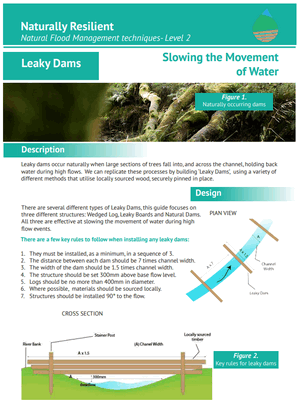Leaky Dams
https://www.therrc.co.uk/MOT/References/WT_Managing_woody_debris.pdf
References
Leaky Dams
Related Structures & Concepts
- DeVries P, Fetherston KL, Vitale A and Madsen S. 2012. Emulating Riverine Landscape Controls of Beaver in Stream Restoration. Fisheries. 37(6): 246-255. DOI: 10.1080/03632415.2012.687263. - These ‘low walls’ are very similar to the ‘leaky dams’ .

Figure 5 from DeVries et al (2012) showing ‘log wall’, ‘engneered-flow choke’ structures similar to the ‘leaky dams’, intended to ‘emulate effects of beaver dam’.
-
Stratford C, Miller J, House A, Old G, Acreman M, Dueñas-Lopez MA, Nisbet T, Newman J, Burgess-Gamble L, Chappell N, Clarke S, Leeson L, Monbiot G, Paterson J, Robinson M, Rogers M and Tickner D. 2017. Do trees in UK-relevant river catchments influence fluvial flood peaks? CEH Project no. NEC06063, NERC/Centre for Ecology & Hydrology, Wallingford, UK, 46 pp. - Related News
-
Wheaton J, Fryirs K, Brierley GJ, Bangen SG, Bouwes N and O’Brien G. 2015. Geomorphic Mapping and Taxonomy of Fluvial Landforms. Geomorphology. 248: 273-295. DOI: 10.1016/j.geomorph.2015.07.010.



